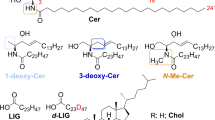Abstract
Ceramides have been proposed to have a central role in the function of the stratum corneum. Ceramides also influence the phase properties of model skin lipid mixtures, but the relevance of this to the stratum corneum function is controversial. Because the stratum corneum contains several classes of ceramides, the type of ceramides used in model mixtures of stratum corneum lipid lamellae may be important. Thus, the properties of α-hydroxy fatty acid containing (HFAC) and nonhydroxy fatty acid containing (NFAC) ceramides and their mixtures have been investigated. Ceramides were obtained by the conversion of purified bovine brain cerebrosides. Isolated, anhydrous HFAC underwent an endothermic solid to liquid transition at 92°C. With hydration, an endothermic transition at 71.8°C was observed which was accompanied by a reduction in the birefringence. The enthalpy increased from 66 to 89 J/g with a 20-d storage time. These thermal properties are very similar to those observed with hydroxy fatty acid containing cerebrosides. In contrast, anhydrous nonhydroxy fatty acid containing ceramides underwent a broad endothermic transition over the temperature range of 50–90°C. When hydrated, the initial endothermic transition was interrupted by an exothermic transition that was followed immediately by a second endothermic transition. During these thermal changes, there was a loss of birefringence, and with completion of the second endothermic transition, a nonbirefringent liquid was observed. NFAC samples, stored at 70°C for 5 min, cooled, and then rescanned, displayed only one endotherm at 75°C. The thermal behavior of mixtures of HFAC and NFAC was relatively simple, with a progressive decrease and broadening in the temperature of the phase transition as the proportion of NFAC increased up to weight fractions of NFAC of 0.7. At lower weight fractions, a plateau in thetransition temperature as a function of weight fraction was observed. Even at a weight fraction of 0.1 HFAC, no transition to a nonbirefringent liquid state was observed. The high enthalpic changes observed with mixtures of HFAC and NFAC are consistent with the proposed central role that ceramides have in the mechanical and permeability properties of the skin. Moreover, the marked difference in the properties of these two similar lipids may help to explain some of the properties of the stratum corneum.
Similar content being viewed by others
Abbreviations
- FID:
-
flame-ionization detector
- HFAC:
-
hydroxy fatty acid containing ceramides
- HFA-CER:
-
hydroxy fatty acid containing cerebrosides
- NFAC:
-
nonhydroxy fatty acid containing ceramides
- NFA-CER:
-
nonhydroxy fatty acid containing cerebrosides
- TLC:
-
thin-layer chromatography
References
Bergelson, L.D. (1980)Lipid Biochemical Preparations, pp. 113–124, Elsevier, New York.
Lampe, M.A., Burlingame, A.L., Whitney, J., Williams, M.L., Brown, B.E., Roitman, E., and Elias, P.M. (1983)J. Lipid Res. 24, 120–130.
Lampe, M.A., Williams, M.L., and Elias, P.M. (1983)J. Lipid Res. 24, 131–140.
Wertz, P.W., and Downing, D.T. (1983)J. Lipid Res. 24, 759–765.
Williams, M.C., and Elias, P.M. (1982)CRC Crit. Rev. Therap. Drug Carrier Syst. 3, 95–122.
Elias, P.M., Cooper, E.R., Korc, A., and Brown, B.E. (1981)J. Invest. Dermatol. 76, 297–301.
Elias, P.M., Goerke, J., and Friend, D.S. (1977)J. Invest. Dermatol. 69, 535–546.
Wertz, P.W., and Downing, D.T. (1982)Science 217, 1261–1262.
Karlsson, K.-A., and Pascher, I. (1971)J. Lipid Res. 12, 466–472.
Pascher, I. (1976)Biochim. Biophys. Acta 455, 433–451.
Lofgren, H., and Pascher, I. (1977)Chem. Phys. Lipids 20, 273–284.
Pascher, I., and Sundell, S. (1977)Chem. Phys. Lipids 20, 175–191.
Wertz, P.W., Sartzendruber, D.C., Kitko, D.J., Madison, K.C., and Downing, D.T. (1989)J. Invest. Dermatol. 93, 169–172.
Abraham, W., and Downing, D.T. (1991)Biochim. Biophys. Acta 1068, 189–194.
Fenske, D.B., Thewalt, J., Bloom, M., Kitson, N. (1994)Biophys. J. 67, 1562–1573.
Ongpipattanakul, B., Francoeur, M.L., and Potts, R.O. (1994)Biochim. Biophys. Acta 1190, 115–122.
Bouwstra, J.A., de Vries, M.A., Gooris, G.S., Bras, W., Brussee, J., and Ponec, M. (1991)J. Control. Rel. 15, 209–220.
Mattai, J., Froebe, C.L., Rhein, L.D., Simion, F.A., Ohlmeyer, H., Su, D.T., and Friberg, S.E. (1993)J. Soc. Cosmet. Chem. 44, 89–100.
Radin, N.S. (1976)J. Lipid Res. 17, 290–293.
Carter, H.E., Rothfus, J.A., and Gigg, R. (1961)J. Lipid Res. 2, 228–234.
Wiedmann, T.S., and Salmon, A. (1991)Lipids 26, 364–368.
Mabrey, S., and Sturtevant, J.M. (1976)Proc. Natl. Acad. Sci. USA 73, 3862–3870.
O'Brien, J.L., and Rouser, G. (1964)J. Lipid Res. 5, 339–347.
Shah, J., Atienza, J., Rawlings, A.V., and Shipley, G.G. (1994)Biophys. J. 66, A288.
Curatolo, W. (1982)Biochemistry 21, 1761–1764.
Curatolo, W., and Jungalwala, F.B. (1985)Biochemistry 24, 6608–6613.
Wu, W-G., Chong, P.L-G., and Guang, C-H. (1985)Biophys. J. 47, 237–242.
White, S.H., Mirejovsky, D., and King, G.I. (1988)Biochemistry 27, 3725–3732.
Ruocco, M.J., Atkinson, D., Small, D.M., Skarjune, R.P., Oldfield, E., and Shipley, G.G. (1981)Biochemistry 20, 5957–5966.
Bunow, M.R. (1979)Biochim. Biophys. Acta 574, 542–546.
Jackson, M., Johnston, D.S., and Chapman, D. (1988)Biochim. Biophys. Acta 944, 497–506.
Johnston, D.S., and Chapman, D. (1988)Biochim. Biophys. Acta 939, 603–614.
Rehfeld, S.J., Plachy, W.Z., Williams, M.L., and Elias, P.M. (1988)J. Invest. Dermatol. 91, 499–505.
Author information
Authors and Affiliations
About this article
Cite this article
Han, CH., Sanftleben, R. & Wiedmann, T.S. Phase properties of mixtures of ceramides. Lipids 30, 121–128 (1995). https://doi.org/10.1007/BF02538264
Received:
Revised:
Accepted:
Issue Date:
DOI: https://doi.org/10.1007/BF02538264




